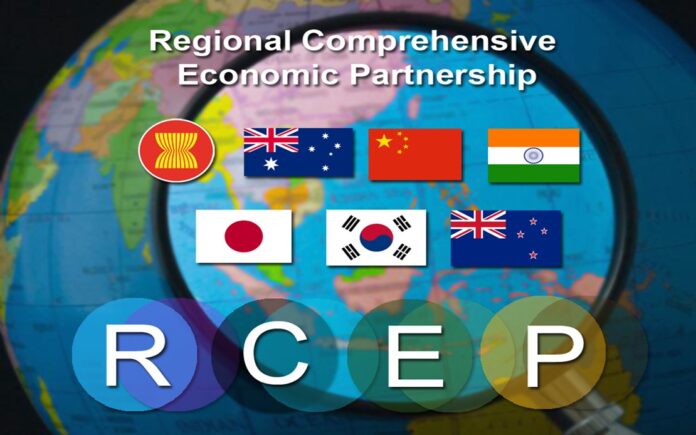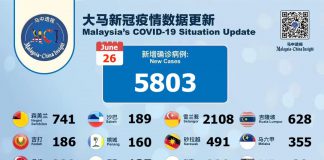KUALA LUMPUR, Aug 22 — The ASEAN Business Advisory Council (ASEAN-BAC) and non-ASEAN Business Council are ramping up efforts to increase and facilitate trade and investment opportunities within the region to leverage the regional comprehensive economic partnership (RCEP) which came into force earlier this year.
Speaking to Bernama in conjunction with the ASEAN 55th anniversary, Tan Sri Dr Munir Abdul Majid, the chairman of ASEAN-BAC said there is no doubt that the RCEP offers huge economic opportunities, especially when the member economies are still striving to recover post-COVID-19.
As it enters into force, the trade pact would pave the way for the creation of the world’s largest free trade area. In Malaysia, the RCEP came into force on March 18.
“On the plus side, this world’s largest regional free trade agreement is 30 per cent of almost everything – of global gross domestic product, population and et cetera – but on the minus side it is still only 30 per cent of that everything, not 100 per cent.
“There will be this regional growth and, in time, increase in that 30 per cent which makes it both a pre-eminent regional platform for expanded economic activity and cooperation, as well as a reminder of how much better it would be if there was world-wide openness and understanding on trade and investment,” he said.
According to World Bank data, the agreement would cover 2.3 billion people or 30 per cent of the world’s population, contributing US$25.8 trillion or about 30 per cent of global gross domestic product and account for US$12.7 trillion, over a quarter of global trade in goods and services, and 31 per cent of global foreign direct investment inflows.
Still, Munir said that having the RCEP is something precious to build upon, and China sees this.
As the pact took effect, China has published a national guideline for high-quality RCEP implementation in six areas: trade and investment; upgrading manufacturing; cooperation on standards; financial support; business environment; and support services for enterprises.
“Efforts will also be made to expand renminbi settlement. China has targeted various markets. Implementation to achieve strategic objectives are planned at local and provincial level,” he shared.
Establishing RCEP blueprint
Munir recommended that Malaysia should also do the same to take advantage of RCEP by coming out with a similarly detailed blueprint to secure RCEP success for the country, rather than just rest on the laurels of expected gains in exports of US$0.2 billion, as projected by the United Nations Conference on Trade and Development (UNCTAD) in a study published by UNCTAD in mid-December 2021.
A study by the Asian Development Bank revealed that the RCEP would increase the member economies’ incomes by 0.6 per cent by 2030, adding US$245 billion (RM1.1 trillion) annually to regional income and 2.8 million jobs to regional employment.
Meanwhile, Malaysia’s Ministry of International Trade and Industry data saw that for the period between March and June 30, the country’s export value for the export of goods under the RCEP stood at RM31.9 million.
“Malaysia can achieve more, and not just in terms of trade alone, by being similarly focused on strategic planning and execution,” Munir stressed.
Interestingly, he said, China has expressed interest to join the Comprehensive and Progressive Agreement for Trans-Pacific Partnership (CPTPP), as it sees opportunities to penetrate markets such as Canada and Mexico on that platform.
“Malaysia should similarly take the opportunity of penetrating those markets by ratifying the CPTPP soon. Vietnam, a member of both the RCEP and the CPTPP, has seen huge investments coming in and expanded exports going out,” he revealed.
Despite being an active participant in the CPTPP negotiations, Malaysia has yet to ratify the agreement.
If ratified, the country is expected to benefit in the medium to long term as part of the pact in five sectors, namely electrical and electronics, palm oil, chemicals, optical and scientific equipment, and plastics.
Do not be complacent
Munir noted that ASEAN remains one of the fastest growing regions in the world, with factor endowments favouring continued expansion of the economy.
But he is concerned that while the region is a magnet to investments which is a blessing, it causes member countries to be complacent and not work together enough to achieve the reality of a single market, the third most populous, approaching an economy of US$4 trillion.
“With RCEP, the discipline of adhering to integration agreements would force ASEAN to be more integrated itself,” he said, adding that ASEAN must work together to minimise the impact and to work together to exploit new opportunities and to become more efficient.
He said ASEAN still needs to harmonise standards to achieve sustainable growth, not just growth at all cost, particularly to the environment.
The danger is, something already happening in the advanced economies, the abandonment of Sustainable Development Goals (SDG) standards, like clean energy, in the pressure-cooker of economic challenges, he concluded.
‘Stronger Together’ ASEAN
In conjunction with the ASEAN 55th anniversary month, Munir, who is well known in the Malaysian corporate world said there has been no time for celebration post the pandemic.
“We are barely out of the frying pan and already are in the fire. Shortages, surge in food and gas prices, inflation, rise in interest rates, are all not conducive to global economic recovery, and many major economies are in fact weakening – which contract markets for ASEAN exports,” he said.
In line with the global economy, the ASEAN economy remains weak amid rising inflation with the inflation rate projected to increase to 4.7 per cent this year from 3.7 per cent, according to the Asian Development Bank (ADB).
Among the 10 member economies, ADB said Laos has one of the highest inflation rates in the region, at 23.6 per cent year-on-year in June, while Vietnam recorded the lowest inflation rate at 3.37 per cent followed by Malaysia (second lowest inflation rate) at 3.4 per cent.
“Combined with geopolitical tensions, the world is not in a good place and ASEAN not excepted… but the most important thing is to achieve results and follow-through whatever the mode of the meetings – which ASEAN has plenty of,” he said.
Munir also shared that at the ASEAN-BAC Malaysian and regional level, the council has employed a hybrid form of activity to push further cooperation in the ASEAN Economic Community (AEC).
Themed ‘Stronger Together’, this year’s ASEAN Day invited and welcomes forward-minded people of ASEAN to come in synchronisation and work collectively to face the challenges of the 21st Century.
Established on Aug 8, 1967 in Bangkok, Thailand, the ASEAN founding members are Indonesia, Malaysia, the Philippines, Singapore and Thailand. Brunei Darussalam joined the pact in 1984, Vietnam (1995), Laos and Myanmar (1997) and Cambodia (1999).
















